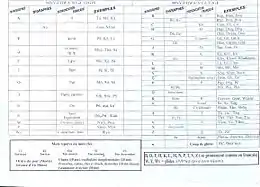Ghomalaʼ language
Ghɔmálá’, or Bamileke-Banjun (Bamiléké-Bandjoun), is a major Bamileke language of Cameroon.
| Ghomala | |
|---|---|
| Ghɔmálá’ | |
| Region | Cameroon |
| Ethnicity | Bamileke |
Native speakers | 350,000 (2005)[1] |
| Language codes | |
| ISO 639-3 | bbj |
| Glottolog | ghom1247 |

Alphabet of the Ghomala' language
It is spoken by an estimated 1.1 million people in two main population groups.[2]
Phonology
Consonants
| Labial | Alveolar | Palatal | Velar | Glottal | ||
|---|---|---|---|---|---|---|
| Plosive | voiceless | p | t | k | ʔ | |
| voiced | b | d | ɡ | |||
| Affricate | voiceless | p͡f | t͡s | t͡ʃ | ||
| voiced | b͡v | d͡z | d͡ʒ | |||
| Fricative | voiceless | f | s | (ʃ) | h | |
| voiced | (v) | (ʒ) | (ɣ) | |||
| Nasal | m | n | ŋ | |||
| Approximant | lateral | (l) | ||||
| central | w | j | ||||
| centralized | ɥ̈ | |||||
- The glottal stop /ʔ/ only occurs as word-final.
- Sounds [v l ʃ ʒ ɣ] are alternative consonant sounds of /b͡v d t͡ʃ d͡ʒ ɡ/.
- /t d/, when occurring before close front-central vowel sounds /i ʉ/, can sound palatalized as [tʲ dʲ].
- Sounds /p b t d k/, when preceding a /h/ sound, are realized as affricated [p͡ɸ b͡β t͡θ d͡ð k͡x].
- /ɡ/, when occurring before central vowel sounds /ə ɐ/, may sound affricated as [ɡ͡ɣ].
- A word-final /k/ sound, may be realized as uvular sounds [q χ].
Vowels
| Front | Central | Back | |
|---|---|---|---|
| High | i | ʉ | u |
| Mid | e | ə | o |
| ɛ | ɐ | ɔ | |
| Low | a |
- Sounds /ɐ u ɔ/ when occurring with a velar nasal /ŋ/, can be realized as nasalized vowel sounds [ɐ̃ ũ ɔ̃].[3]
Tone
Tones are marked as high [á], low [à], central (unmarked) [a], rising [ǎ], or falling [â].
References
- Ghomala at Ethnologue (18th ed., 2015) (subscription required)
- "Ghomala Language | Joshua Project". joshuaproject.net. Retrieved 2020-10-27.
- Nissim, Gabriel M. (1981). Le Bamileke-Ghomálá' (Parler de Bandjoun, Cameroun). Paris: Centre National de la Recherche Sciéntifique.
This article is issued from Wikipedia. The text is licensed under Creative Commons - Attribution - Sharealike. Additional terms may apply for the media files.